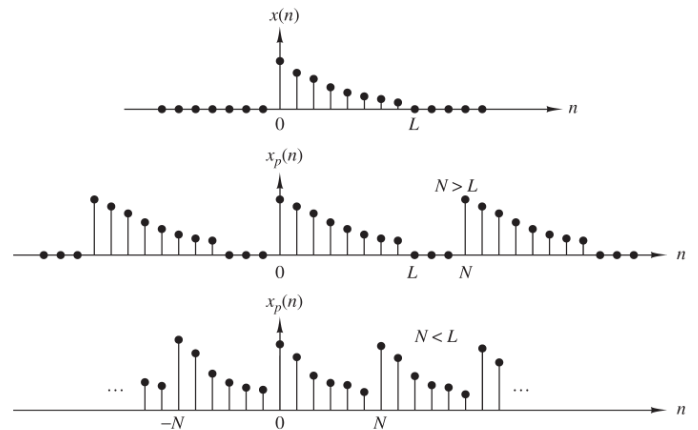Resources: 6.1, 7.1, 7.1.2, 7.2.1, 7.3.1, 7.4, 8.1.3
Problem 1
Given the following sequence of length
Where
a)
We can now compute using the formula for a finite geometric seriesDTFT - Discrete Time Fourier Transform
DTFT is a way of looking at the signal in the frequency domain. The formula is given by
Link to original
Finite Geometric Series
Link to original
X(\omega)&= \sum_{n=0}^{N_{x}-1}0.9^ne^{-j\omega n} \\ X(\omega)&= \sum_{n=0}^{N_{x}-1}(0.9e^{-j\omega})^n \\ X(\omega)&= \frac{1-(0.9e^{-j\omega})^{N_{x}}}{1-0.9e^{-j\omega}} \end{align}
b)
c) The relationship is given by
where is the number of points.
d) After plotting, we can clearly see that the DFT-values are not accurate when the number of samples for the DFT are too small. In this case, .
e) Since real discrete values signals are unique only for , we only care about values in this range. However, due to the symmetrical properties of the DTFT and DFT, it is symmetrical around , therefore we only need to look at the frequency range .
Problem 2
Given the following sequence of length
a) The length of a convolution between a signal (with length ), and a filter (with length ), is given by
Which is the same as the plot
b)
To avoid Time Domain Aliasing we need the length of the DFT to be atleast equal to . This is shown through the following figure.

Problem 3
Problem 4
a) The Fast Fourier Transform is a more computationally efficient way of computing the DFT. There are several algorithms that does this.
b) The Radix-2 FFT is an algorithm that can be used when , and we can use zero padding to achieve the correct number of points. Using a divide and conquer algorithm that uses the symmetric properties of the window function. It reduces the runtime from to .
c) Solving directly gives us
Link to originalWhich has a runtime of
d)